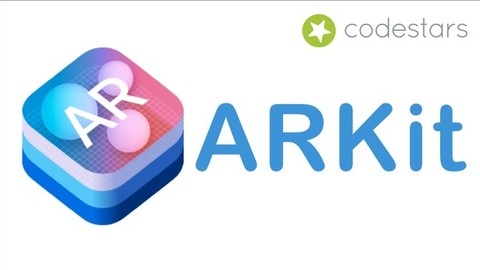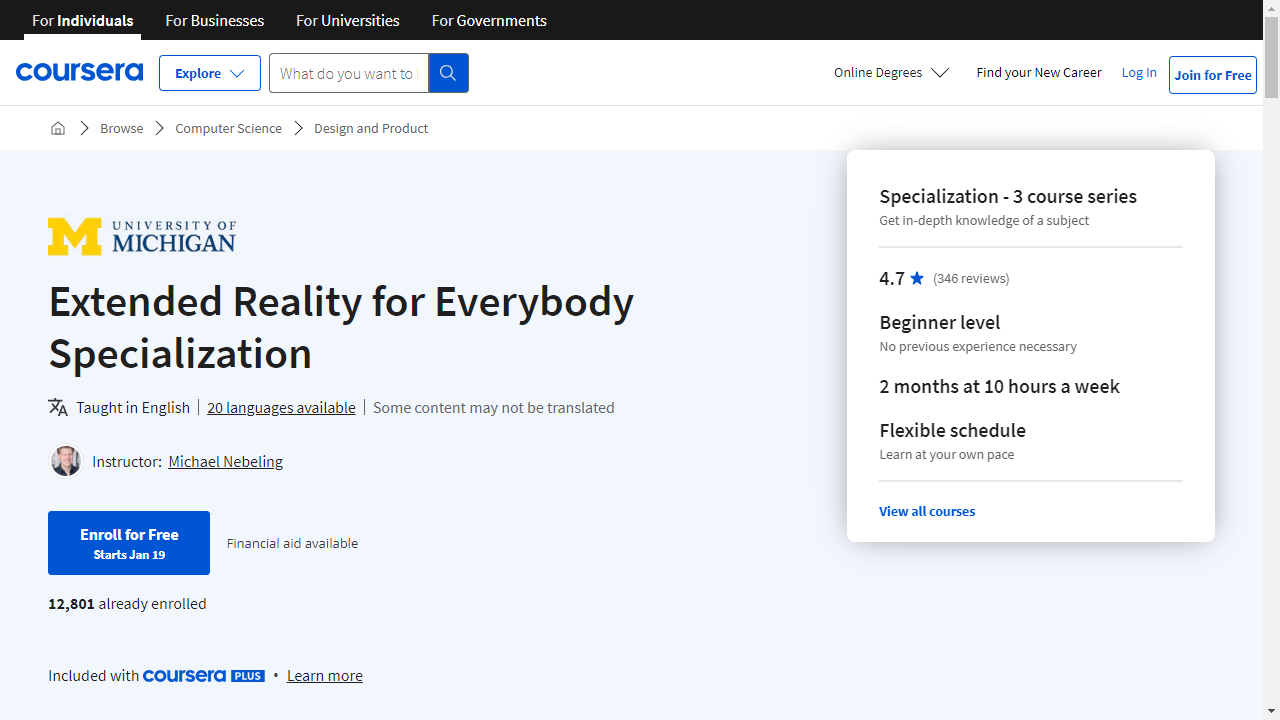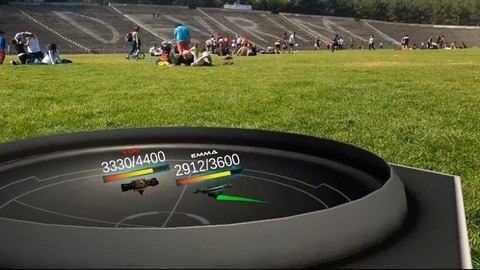Augmented reality (AR) is revolutionizing the way we interact with the world around us, blending digital content with our physical environment.
From interactive games and immersive shopping experiences to educational tools and industrial applications, AR is transforming various industries and creating exciting opportunities for developers and creators.
By learning AR development, you can gain valuable skills in a rapidly growing field, enabling you to build innovative applications and shape the future of this technology.
Finding the right augmented reality course can be a daunting task, with numerous options available online.
You’re looking for a program that not only covers the fundamental concepts but also provides practical, hands-on experience to build your AR development skills.
You want a course that’s engaging, comprehensive, and taught by industry experts who can guide you through the complexities of AR development.
For the best augmented reality course overall, we recommend the Meta AR Developer Professional Certificate on Coursera.
This comprehensive program equips you with the skills needed to create engaging AR experiences across various platforms, including social media, the web, and mobile games.
Developed by Meta, a leader in the AR industry, this certificate program provides a strong foundation in AR development principles, tools, and techniques.
While the Meta AR Developer Professional Certificate is our top pick, there are other excellent options available, catering to different learning styles, skill levels, and specific interests within the AR field.
Keep reading to explore our curated list of the best augmented reality courses, including programs focused on popular AR platforms like ARKit, Meta Spark, and Unity.
Meta AR Developer Professional Certificate
Provider: Coursera
The Meta AR Developer Professional Certificate on Coursera is a top choice if you want to learn about building immersive AR experiences.
This program equips you with the skills to create engaging AR applications across various platforms, from social media to the web and mobile games.
The certificate program begins with the fundamentals of AR, covering its position within XR and its uses in various industries.
You will explore AR’s potential in marketing, education, gaming, and entertainment.
You will also delve into computer vision, a crucial element of AR development, and gain a comprehensive understanding of the software development lifecycle.
You will then discover various AR platforms and tools, including Meta Spark, web AR, and mobile AR.
You will learn to create AR effects for social media marketing using Meta Spark Studio and publish them on platforms like Instagram.
You will also dive into web AR development using JavaScript, PlayCanvas, and Blender to build interactive web-based AR experiences.
The program will then guide you through building AR games using Unity, a powerful game development engine.
You will learn to use Unity paired with C# to create immersive mobile AR games.
This includes techniques like marker detection, plane tracking, and using the AR Foundation API.
You will also get hands-on experience with Vuforia SDK, a tool for creating advanced AR applications.
The Complete ARKit Course - Build 11 Augmented Reality Apps
Provider: Udemy
This course on building augmented reality apps for iPhones using Apple’s ARKit begins with the fundamentals.
You will familiarize yourself with Xcode and Swift, the essential tools and programming language for ARKit development.
The course guides you through the basics of app creation, setting the stage for your journey into augmented reality.
You will then dive into the core concepts of ARKit, starting with nodes.
You will learn how to work with these building blocks of AR experiences.
The course teaches you how to track the real world using your iPhone’s camera and how to precisely position and manipulate objects within your AR scenes.
You will master techniques like rotation, scaling, and relative positioning, giving you fine-grained control over the objects in your AR world.
This course doesn’t shy away from advanced concepts either.
You will discover how to bring your AR apps to life with textures and surfaces.
You will explore plane detection, which allows you to seamlessly integrate virtual objects with horizontal surfaces in the real world.
You will even delve into the intricacies of vehicular physics, learning how to simulate realistic car movement using physics bodies, accelerometer data, and steering mechanisms.
You will work with 3D models, hit-testing, and animations.
The course guides you through creating compelling visual effects, like lava flowing realistically on a detected plane.
Build 15 Augmented Reality (AR) apps with Unity & Vuforia
Provider: Udemy
This Udemy course teaches you how to make 15 different augmented reality (AR) apps.
You’ll use Unity, a popular game development software, and Vuforia, a platform specifically for making AR experiences.
If you’re interested in AR and want to learn by doing, this course is a great place to start.
You’ll begin with the fundamentals: what AR is, how it differs from VR, and the basics of using Unity.
You’ll learn to navigate Unity’s interface, manipulate objects, and grasp essential concepts like physics and lighting.
This foundation prepares you for building more complex AR apps.
The course then delves into practical AR development using Vuforia.
You’ll discover how to import the Vuforia package, work with image targets, and project 3D models onto them.
As you progress, you’ll tackle advanced techniques like markerless AR (placing objects without image targets), object tracking, and even Vuforia’s cloud recognition, which lets you pull information from a database and display it in your AR app.
You’ll create an AR book with interactive 3D models and text, an AR greeting card that tracks multiple images at once, and an AR business card with virtual buttons that trigger actions like playing videos.
You’ll also explore Vumark, a Vuforia feature that allows you to encode and decode data within your AR experiences.
Extended Reality for Everybody Specialization
Provider: Coursera
This three-course specialization begins by explaining the differences between AR, VR, MR, and XR technologies.
You will explore the current XR landscape, including platforms, devices, and applications like A-Frame, Unity, and Unreal.
This first course helps you understand how to incorporate XR into new projects.
The second course teaches you how to design new user experiences for XR, using design thinking techniques and rapid prototyping methods.
You will learn how to create storyboards and physical prototypes, as well as digital prototypes using immersive authoring tools.
You will study user-centered design and ethical considerations in XR development.
The final course focuses on the technical development of XR applications, teaching you how to create basic and immersive VR and AR scenes.
You will learn about the major XR development platforms and discover how to estimate development costs, plan research, and address ethical considerations in your projects.
The course covers the use of WebXR and Unity for building XR experiences.
Augmented Reality in Depth 101
Provider: Udemy
You will start with the basics, learning about the difference between augmented reality and virtual reality, and different display technologies.
You will then learn how AR is being used in the real world today.
The course then dives into the exciting world of building AR apps using Unity3D and Vuforia.
You will get hands-on experience setting up these powerful tools and creating your very first AR application, learning how to use Vuforia Image Targets to make your app come to life.
As you progress through the course, you will work on increasingly challenging projects like building a virtual globe and a 2D page curl app.
These projects will teach you how to work with cylindrical targets, multi-image targets, and user-defined targets.
Through these projects, you will develop valuable skills in AR development.
You will learn how to script functionalities, import assets and animated 3D models from platforms like Mixamo, and test your apps on iOS.
You’ll master using tools such as PhotoScape to edit images for your AR experiences.
You will even discover how to use the Vuforia Object Scanner to create superimposition effects and explore advanced concepts like Ground Plane to make your AR experiences even more interactive.
Virtual Reality Specialization
Provider: Coursera
This course starts by covering the basics of VR, like the history of VR and the hardware used, including Oculus Rift and HTC Vive.
You will also learn about the psychology of VR and some of its challenges.
The specialization then dives into creating VR experiences.
Using Unity3D, you will master the art of 3D graphics, including how to create lifelike environments and objects using materials and texturing.
The program emphasizes techniques for optimizing performance, a critical aspect of VR development.
You will then learn how users interact with virtual worlds.
This involves understanding the technologies behind VR interaction, like creating realistic character movements and object manipulation within a virtual world.
You will design a VR interaction project based on advice from experts in the field.
Next, you’ll explore the world of social VR and learn how to build interactive 3D characters.
This includes 3D character animation and programming characters to respond to a player’s speech and body language.
You’ll also dive into avatars, which represent other players, and agents, which are computer-controlled NPC characters.
Finally, you’ll bring everything you’ve learned together to create your first VR game.
You’ll experience the complete VR project lifecycle, from brainstorming ideas to storyboarding and prototyping and finally, implementing your game.
To top it off, you’ll receive advice from VR pioneers and creators to help jumpstart your VR development journey.
Build A Multiplayer Augmented Reality (AR) Game With Unity
Provider: Udemy
This course teaches you how to create an augmented reality (AR) game that multiple people can play at the same time.
You start by learning how to make the game work on a single device, like a phone or tablet, using a program called Unity.
You’ll learn how to make objects move realistically using Unity’s physics engine and how to write code that controls how players move and interact with the game world.
Next, you discover how to make your game multiplayer using a tool called Photon.
You connect your game to Photon servers, so players can join games together and see each other’s actions in real-time.
The course teaches you how to make sure everything stays in sync, even if someone has a slower internet connection.
Once you’ve got the basic game up and running, you dive into the exciting world of AR.
Using AR Foundation, you learn how to make your game recognize real-world surfaces, like your floor or a table.
You can then place game objects on these surfaces so they look like they’re actually there!
You learn how to adjust the size and position of objects in the AR world so that everything looks just right.
Finally, you tackle the challenge of making sure all players see the same AR experience, even if they’re using different types of phones.
This involves some clever tricks with code and AR Foundation.
Also check our posts on:







